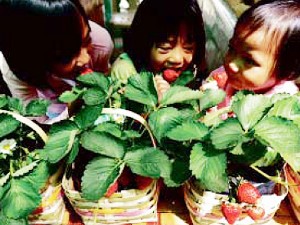LA TRINIDAD, Benguet—The vision of the Regional Development Council (RDC) in the Cordillera is for farmers to start shipping processed and packaged salad instead of daily supplying vegetables and fruits to Metro Manila markets.
“We want farmers to see that there is even more profit in processing their produce,” says Virgilio Bautista, RDC co-chair.
That aspiration may be coming true, at least for those engaged in the strawberry industry in this Benguet capital. This month’s staging of the strawberry festival offered tourists soap bars, pastries, wine and ice cream made from luscious berries grown in the La Trinidad valley.
Menchie’s Homemade Cakes has been in business for five years now, operating from a house on Kilometer 4 here.
Shop owner Normacita Obar, 44, says her strawberry-flavored donuts, twists and cookies, earned for her P3,500 a day during the festival’s Strawberry Trade Fair.
Cranberry Bakeshop has delighted customers with “chocoberry” cakes sold for P35 a slice. Health conscious tourists at the festival bought strawberry butter for P100 a bottle.
Strawberry plantation areas, which produce La Trinidad’s most famous product, have been shrinking due to an increasing population, which has been troubling these enterprises.
Felicitas Ticbaen, La Trinidad agriculturist says that in 2013 strawberry farmers would try new technologies to help increase their yield through the help of the Japan Agriculture Exchange Council.
Through new farming methods, farmers will try to grow strawberries during the rainy season, says Ticbaen.
She says strawberry varieties from the United States were introduced here before World War II, and Ibaloi farmers used to call the berries “duting.” The berries were planted at Camp John Hay in Baguio City before farmers started expanding their berry farms here.
When the Japanese invaded the country, they introduced the Japanese strawberry variety to farmers, Ticbaen says.
The Benguet State University (BSU) studied how to make strawberry growing profitable, developing the variety called “Sweet Charlie” in 2004, which became popular with tourists, she says.
It was during the 70s when the government introduced food processing to add value to the strawberries to help improve the lot of the farmer whose produce lasted for only two days, says Jane Avila, a former BSU food technology instructor. With a report from Vincent Cabreza, Inquirer Northern Luzon



